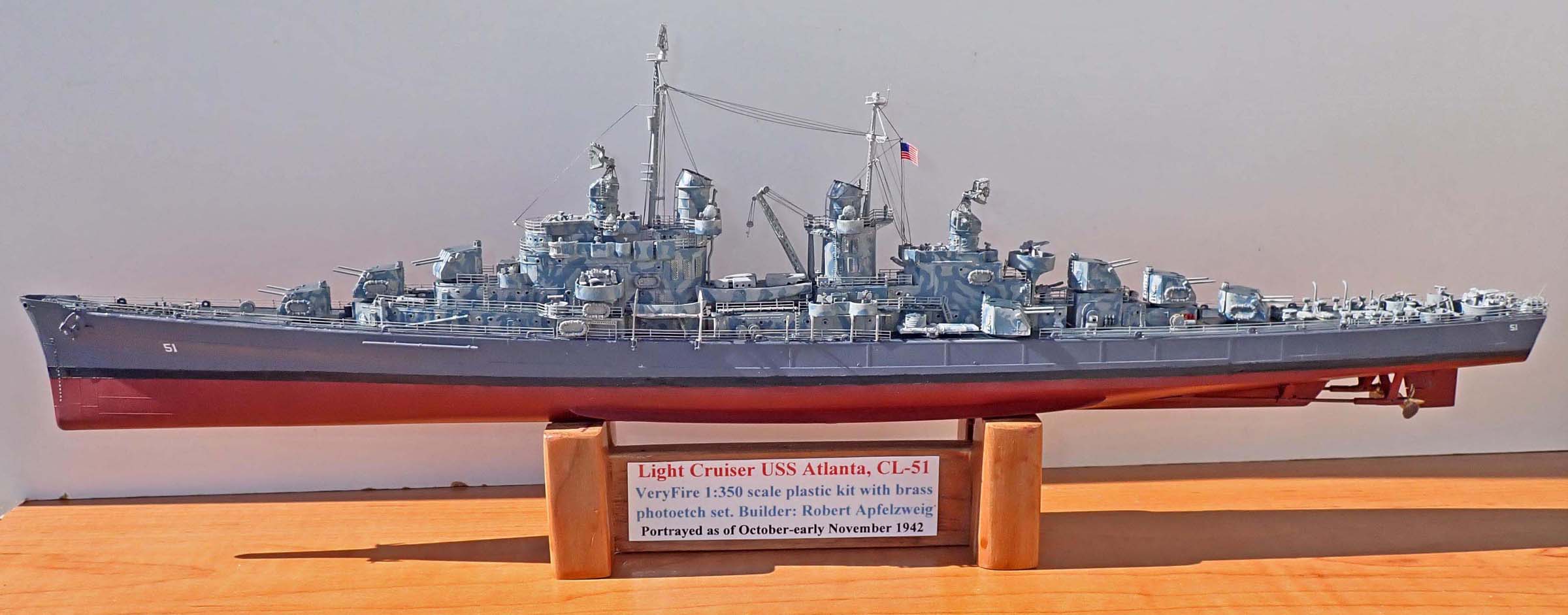
1/350 SS Atlanta CL-51 1942 (VeryFire)
|
by Robert Apfelzweig |

1/350 SS Atlanta CL-51 1942 (VeryFire)
This model kit has been long awaited by many modelers, including myself; light cruisers in general, regardless of from which navy they came, are still relatively uncommon as 1/350 plastic kits. This VeryFire kit (deluxe version, with extensive brass photoetch set) was a fairly straightforward build but demands extraordinary attention to detail in the Modified Measure 12 superstructure painting. For this, I must acknowledge the gorgeous and precise work done on this forum by Dakota Gorder for his May 9, 2022 display -- detail that I tried, and generally failed, to accurately duplicate, although Mr. Gorder admitted that accuracy in this regard is impossible given the limited number of high-resolution photographs of this vessel late in her short career and from different angles. What I will say about this model is that, along with several other recent VeryFire sets (e.g., their USS Cleveland), there are many extra parts, including nearly whole frets, apparently intended for future releases of other ships from this class. Unfortunately, I broke or lost several small parts (plastic and brass) and had to scratch-build or scavenge spare parts replacements because they were not provided in excess on the frets.The USS Atlanta was the first of four ships in this class, commissioned soon after the Pearl Harbor attack and sent into the Pacific cauldron in April 1942 after shakedowns and fitting out. on the East Coast, arriving in time to provide cover for the American aircraft carriers during the Battle of Midway, fulfilling her role (and armament) as an anti-aircraft cruiser. After a period of training she entered the Guadalcanal campaign at the end of July, and screened the USS Enterprise from air attacks during the Battle of the Eastern Solomons the following month. Missing the Battle of Santa Cruz, the Atlanta bombarded suspected Japanese positions on Guadalcanal in October, and screened several US Navy transports unloading troops and cargo for the Marines on Guadalcanal in early November, fighting off numerous attacking Japanese aircraft on November 12 before joining a major surface force that night led by the heavy cruisers San Francisco and Portland, and including the light cruiser Helena (CL-50) and the Atlanta's sistership USS Juneau (CL-52), to intercept a heavier Japanese task force moving down "the slot" to bombard Henderson Field.
The First Naval Battle of Guadalcanal that began a few hours later in the early morning of November 13 has been described as a "drunken brawl in a bar at midnight", with the American and Japanese ships intermingling and firing on each other at often point blank range (or closer). Fighting a surface engagement at night, a situation for which the two anti-aircraft cruisers' relatively light armament and armor were not intended, they fought bravely but both suffered Japanese destroyer-launched torpedo hits that cause severe damage; in addition, the Atlanta, temporarily disabled and drifting, was mistakenly blasted by at least two 8-in. gunned broadsides from the USS San Francisco in the confusion of battle, which mostly blew through her superstructure without exploding, but caused many casualties. By daylight it became apparent that, still lacking power and steadily losing buoyancy from the torpedo hit, the Atlanta needed towing to avoid grounding with the currents, but efforts to help in this way were unsuccessful, and she was abandoned and scuttled, sinking at 20:15 that evening. A worse fate had already overtaken the damaged Juneau; limping along behind the deparing American ships at about 13 knots, she had been struck by a second torpedo at 1100, this time from a Japanese submarine, that ignited her magazines, and the ship blew apart, killing most of her crew, including the five Sullivan brothers.
Both wrecks have been discovered and surveyed; the Atlanta in 1992 in relatively shallow water (400 ft.) by Dr. Robert Ballard and the Juneau in March 2018 by Paul Allen's research crew aboard the RV Petrel using a remotely operated vehicle (ROV) at a depth of nearly 14,000 ft.
Dakota Gorder noted in the description of his USS Atlanta build that he thought that the ship should have 4-bladed, rather than the kit's provided 3-bladed, screws, but recent information from official sources indicates that, although the Atlanta may have been scheduled to have her 3-bladed screws replaced, this was never done, and photos of her wreck show that, despite being partially buried in mud, the ship's screws appear to be 3-bladed. Nonetheless, the kit's screws seemed too small to me, so I used some slightly large ones from my stash of spares.
I completed my model with Tru Color (5-O, 20-B and Antifouling Red) and IPP (5-N) enamel and Mission Models 5-H water-based paints.
